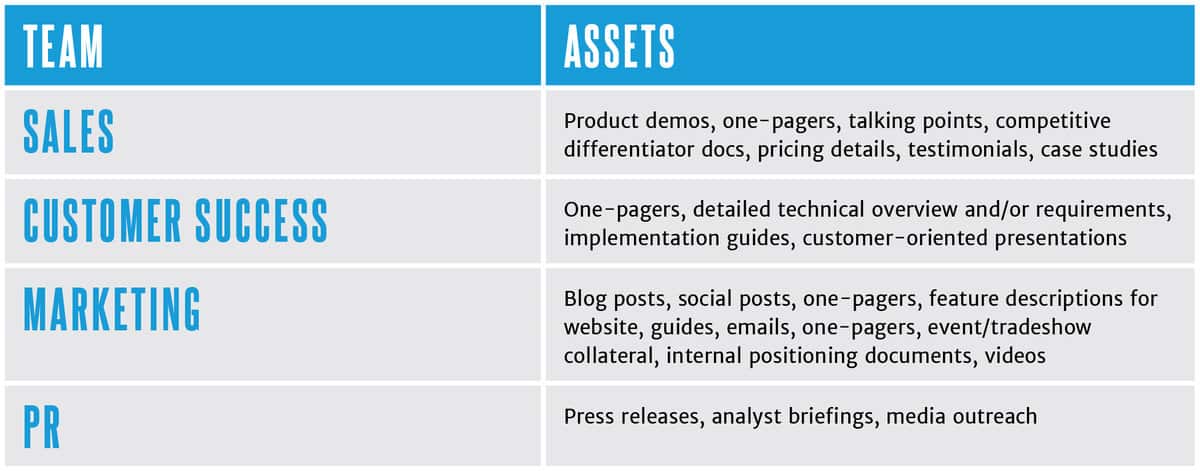
Launching a new B2B product impacts the majority of departments within a company. The sales team is responsible for selling it to potential buyers, the customer support team helps new and current clients successfully implement it, and the marketing and public relations team promotes it in the marketplace.
In a healthy company these departments work together, which is crucial because teamwork is key to a successful product launch. But many B2B companies are working in silos, running the major risk of their launches being but a tiny whisper in the marketplace instead of the fireworks they could be.
We marketers need both our sales and support teams to engage with us to produce better content along the buyer’s journey, and they need us to build key collateral and tools to better sell and support buyers.
It’s common for these teams to struggle to understand one another, and to see the real value in how each can help the other succeed. But it requires real teamwork and a united front across departments to plan a winning B2B product launch plan.
Let’s talk about how we can all play well in the sandbox together, and start to see some game-changing success for your company as a result.
Can I get a Kumbaya, people?
Here are some key strategies that will unite your internal teams and crush your next B2B product launch plan.
1. Pool Internal Knowledge for Better Content-Buyer Alignment
It should come as no surprise that your sales and customer support teams are living, breathing content arsenals. They may not be the ones creating the content, but they are chock full of knowledge about your customers’ pain points, what content is engaging them throughout the buyer’s journey, and what keeps current customers delighted with your product. Not leveraging this internal capital does a major disservice to your marketing team and overall content success.
The fact is, nearly 70% of marketers want to be able to crowdsource ideas more easily from internal workers. Tweet this.
Even more telling is that 80% of C-level executives think they have enough ideas to fuel marketing efforts, but only 36% of managers report having a good process for gathering these ideas.
Only 36% of managers report having a good process for gathering marketing ideas
So how do you start mining this content gold mine and still keep the peace across departments?
Start by scheduling biweekly or monthly debriefs and planning meetings with relevant staff from sales and customer support. Ask them targeted questions to gain insight on potential and current customers. Here are some questions to get you started:
For Sales
- What are the most commonly asked questions by your leads?
- What are the biggest hesitations to purchase that you see among potential buyers?
- Who are the decision makers and other purchase influencers?
- Who are the product champions? Who is generally your first point of contact?
- What pieces of content seem to garner the most impressed responses for buyers? Which ones aren’t effective at all?
- What is your most commonly used content for nurture stage? What about for closing deals?
For Customer Support
- What are some of the more common complaints about the current product?
- What are the most common reasons for customer churn?
- What parts of the product get your customers the most excited?
- What are the biggest communicated value-adds of the product for your end users?
- What pieces of content most commonly upsell current customers?
2. Build a Repository of Content for Internal Use
A solid product launch isn’t just social sharing and top-of-funnel activity. A successful launch requires your internal teams to be fully equipped with quality content for leads and customers at every buyer stage.
Gone are the days of just creating a data sheet, an FAQ, and maybe a slide deck to support a product launch. Tweet this.
But believe it or not, 70% of B2B marketing content isn’t used by sales teams, and only 27% of B2B marketers track content utilization metrics. The result? A lot of wasted content, which means wasted time and dollars spent.
Here are some of the assets needed by each department for product launch success.

Marketing teams must organize all of this content in a central, accessible, and intuitive repository from which various teams can access and distribute content.
There are several mechanisms available for housing assets for internal use. You can use popular cloud platforms like Google Drive or CRM software like Salesforce. These systems can be helpful for storing sales and customer support content in a central repository, but they won’t provide insights on internal use.
Marketing content platforms like Kapost will not only organize your content assets for internal access and distribution, but will also measure the rate of internal engagement to reveal what content is used, shared, and distributed by your teams. This will help your marketing team gain a razor sharp understanding of what content is most effective among sales and customer support so you can adjust your strategy accordingly.
3. Plan an Internal Communications System
If you don’t already have an internal communications system in place, a simple way to start is through traditional email.
Before the product launch, send out an internal launch email to all relevant teams highlighting every asset they’ll need prior to the launch date. Include an overview of the launch plan, and include links to the following:
- Strategic landing pages
- Talking points for each team
- Voicemail script and email drafts for your sales team
- Any other relevant collateral like whitepapers, case studies, or upcoming webinars
This communication will go a long way for rapport between marketing, sales, and customer support, and you can work on refining the communication process in your monthly or biweekly meetings to discuss what worked and what didn’t work, and discover best practices and tweaks to make for the next campaign.
